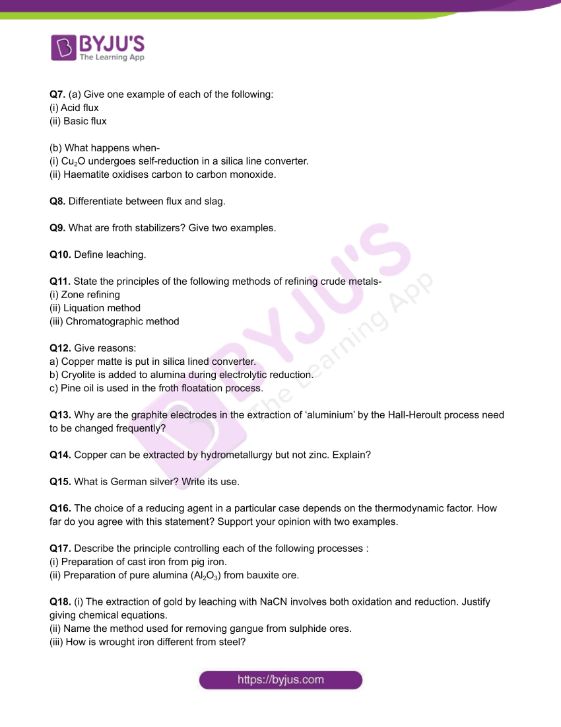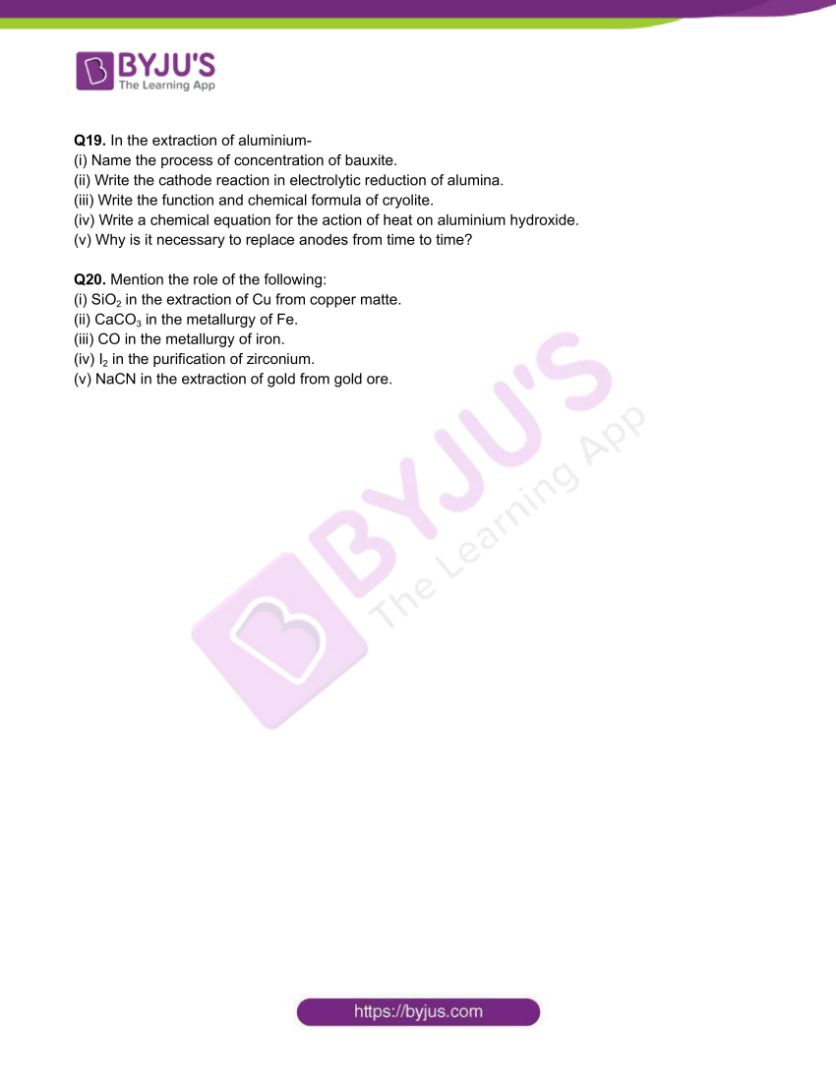Metallurgy is the process of extracting pure metals from their ores. Metals are extracted from their ores using methods based on their reactivity. Electrolysis is used to extract highly reactive metals from their ores, while calcination, roasting, and reduction methods are used to extract metals of medium reactivity. While roasting and refining are used to extract metals with low reactivity from their ores. Although most low reactive metals, such as gold, are found in their free state or in combination with silver and mercury (As amalgam). The concentration of ores is done prior to applying all of these methods of extraction of metals based on their reactivity. Ores are found in nature with a variety of impurities including rock particles, sand, and other impurities. These impurities in an ore are known as matrix or gauge impurities. Concentration ore refers to the removal of a matrix or gauge from the ore.
Download Class 12 Chemistry Worksheet Chapter 6 General Principles and Processes of Isolation of Elements PDF – Set 3
CBSE Class 12 Chemistry Chapter 6 General Principles and Processes of Isolation of Elements Worksheet – Set 3
Q1. The iron produced in the blast furnace is called-
a.) pig iron
b.) wrought iron
c.) cast iron
d.) steel
Q2. 100% copper is obtained from crude copper by:
a.) zone refining method
b.) electrorefining
c.) liquation
d.) None of the above
Q3. Commercial zinc is refined by:
a.) amalgamation
b.) poling
c.) carbon reduction
d.) All of the above
Q4. Unwanted material with ore is called as ____.
a.) Gangue
b.) Rust
c.) Slag
d.) Silica
Q5. Cinnabar is an ore of:
a.) Hg
b.) Cu
c.) Pb
d.) Zn
Q6. Give equations for the industrial extraction of zinc from calamine.
Q7. (a) Give one example of each of the following:
(i) Acid flux
(ii) Basic flux
(b) What happens when-
(i) Cu2O undergoes self-reduction in a silica line converter.
(ii) Haematite oxidises carbon to carbon monoxide.
Q8. Differentiate between flux and slag.
Q9. What are froth stabilizers? Give two examples.
Q10. Define leaching.
Q11. State the principles of the following methods of refining crude metals-
(i) Zone refining
(ii) Liquation method
(iii) Chromatographic method
Q12. Give reasons:
a) Copper matte is put in silica lined converter.
b) Cryolite is added to alumina during electrolytic reduction.
c) Pine oil is used in the froth floatation process.
Q13. Why are the graphite electrodes in the extraction of ‘aluminium’ by the Hall-Heroult process need to be changed frequently?
Q14. Copper can be extracted by hydrometallurgy but not zinc. Explain?
Q15. What is German silver? Write its use.
Q16. The choice of a reducing agent in a particular case depends on the thermodynamic factor. How far do you agree with this statement? Support your opinion with two examples.
Q17. Describe the principle controlling each of the following processes :
(i) Preparation of cast iron from pig iron.
(ii) Preparation of pure alumina (Al2O3) from bauxite ore.
Q18. (i) The extraction of gold by leaching with NaCN involves both oxidation and reduction. Justify giving chemical equations.
(ii) Name the method used for removing gangue from sulphide ores.
(iii) How is wrought iron different from steel?
Q19. In the extraction of aluminium-
(i) Name the process of concentration of bauxite.
(ii) Write the cathode reaction in electrolytic reduction of alumina.
(iii) Write the function and chemical formula of cryolite.
(iv) Write a chemical equation for the action of heat on aluminium hydroxide.
(v) Why is it necessary to replace anodes from time to time?
Q20. Mention the role of the following:
(i) SiO2 in the extraction of Cu from copper matte.
(ii) CaCO3 in the metallurgy of Fe.
(iii) CO in the metallurgy of iron.
(iv) I2 in the purification of zirconium.
(v) NaCN in the extraction of gold from gold ore.
Download PDF to access answers of Chemistry Worksheet for Class 12 Chemistry Chapter 6 General Principles and Processes of Isolation of Elements Set -3.
Download PDF
Read Also:
- General Principles and Processes of Isolation of Elements Class 12 Notes Chapter 6
- General principles and Processes of Isolation of Elements MCQs
- NCERT Solutions for Class 12 Chemistry Chapter 6 General Principles and Processes of Isolation of Elements
- Important Questions for Class 12 Chemistry Chapter 6 – General Principles and Processes of Isolation of Elements



Comments